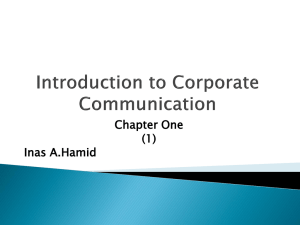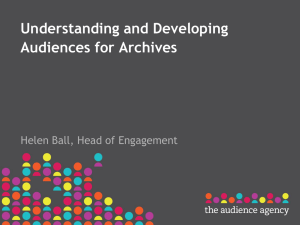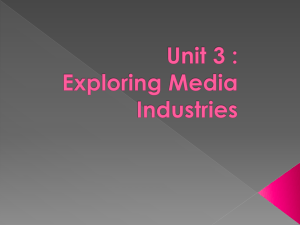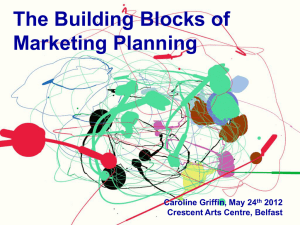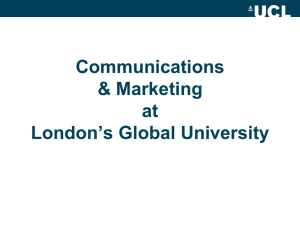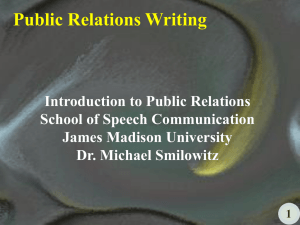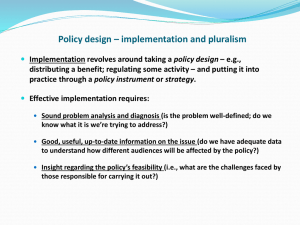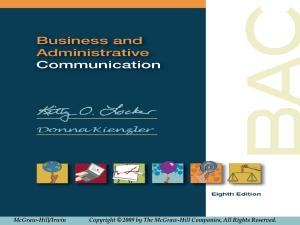Writing a communications strategy
advertisement
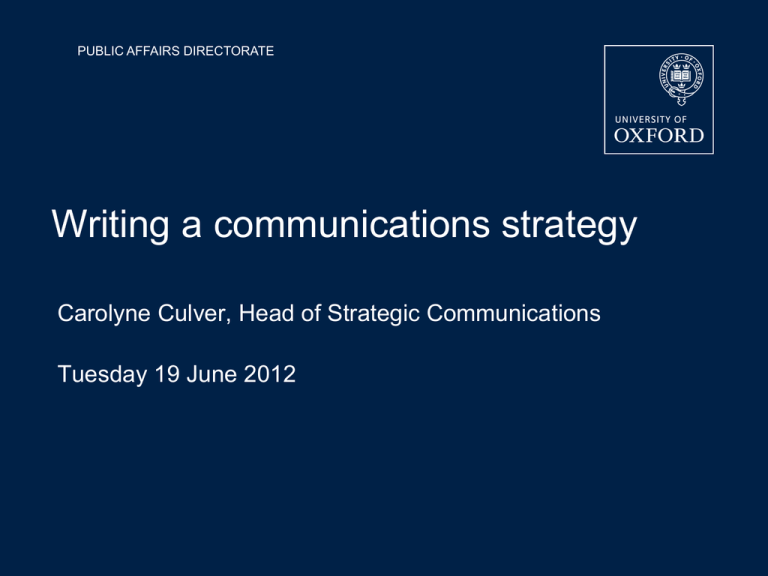
PUBLIC AFFAIRS DIRECTORATE Writing a communications strategy Carolyne Culver, Head of Strategic Communications Tuesday 19 June 2012 What is a strategy? A plan of action designed to achieve a vision. All about gaining a position of advantage over adversaries or best exploiting emerging possibilities. A detailed plan for achieving success in situations such as war, politics, business, industry or sport. Organisation’s strategy Types of communications strategy Organisation – ideally reviewed annually Major, complex, long term project – e.g. ROQ project A major announcement – e.g. new endowment which will fund a scholarship programme A big event – e.g. a conference Building and opening a new building What is a communications strategy? Written document – not just in people’s heads Collaboration between the project leader(s) and the communications professional(s) A reference document against which to judge progress Contains clear and measurable objectives Identifies relevant audiences A plan of activities and a timetable Identifies resources – financial and people Why is a strategy important? “Why don’t we just get on with it?” Taking time to agree what you want to achieve Plan ahead rather than last minute panic Exploit all the channels available to you Agree responsibilities Identify and seek resources Identify risks and plan how to deal with them A plan against which to measure success A process which helps you learn lessons for the future A comprehensive communications strategy Research Messages Mission Channels Vision Timing Aims Resources Objectives Risks Audiences Evaluation Background research What are your objectives? Your strengths, weaknesses, opportunities and threats? Learn lessons from previous projects Learn lessons from peers’ and competitors’ experiences Look at past media coverage, event attendance, web visits Speak to colleagues – experienced and fresh-faced Focus groups and surveys among your key audiences Mission (purpose) + vision (ambition) National Trust We're a UK conservation charity, protecting historic places and green spaces, and opening them up forever, for everyone. Cancer Research UK We are the world's leading charity dedicated to saving lives through research. Mission (purpose) + vision (ambition) University of Oxford Oxford’s mission is to provide excellent teaching and conduct excellent research Oxford’s vision is to be world leading Aims Engage and persuade audiences of the value (for money) of an Oxford education and the personal and public benefit that flows from it Persuade audiences of Oxford’s commitment to improving access and widening participation Demonstrate the impact of Oxford research and persuade audiences of the value of public funding for research Objectives need to be SMART Specific, significant, simple Measurable, manageable Achievable, agreed, assignable Relevant, resourced Time bound, trackable Objectives need to be smart Not SMART: “We need to raise more money.” SMART: “We want to raise £5million to set up a fund to create an extra 20 graduate scholarships from October 2014.” There can be one or more objectives Audiences HEFCE, research councils, charities, NHS etc UK government, local council Your colleagues, the wider University Alumni Donors Future applicants Local community: residents, businesses, groups Media: local, national, specialist Audiences Two considerations… Who holds the keys to success or failure? And who influences those people? And… Don’t forgot the internal audience – e.g. students and colleagues in your department or college, people in your division Categorise your audiences in relation to your situation and your objectives Power/influence + interest + supportive – your partners in achieving your objectives Power/influence + interest + opposed – use persuasion and dialogue; accurate coverage of your objectives/views; correct their claims Power/influence + not interested – capture their attention; enlist the help of your partners Use third parties to help persuade and create interest Messages What do you want them to know? What do you want them to think? What do you want them to do? Why should I care? How does it affect me? Tailor them but avoid contradiction and false promises Statistics and case studies Third party endorsements Make people sit up and listen “Oxford offers the most generous bursary package to undergraduate students from the least well off households” Inspire action “We need 5,000 signatures on our petition to the local council to save our library” Channels of communication Media: local, national, international; print, broadcast, web, social Lobbying: local and national government, funding bodies, special interest groups Marketing: brand, website, advertising, brochures, fliers, video Events: conferences, launch events, public speeches, tours of building sites Timing Work backwards from your deadline Accommodate long lead-in times Exploit ‘hooks’ to attract interest Availability of spokespeople and venues Coordinate who is told what and when Create a timetable of activities Monitor timetable and adjust as necessary Timetable September 2012 October 2012 November 2012 Ask local MP to book venue Send out invitations Event in parliament Media Identify key messages and spokespeople Propose an interview Issue press release Publications Design invitation and display boards Print the materials Distribute the materials at the event Lobbying Resources: people and money Who do you ideally need to assist you? Who is actually available to assist you? What funds do you need? What funds do you have? Do you need to bid for extra? From whom? When? Are there conditions attached to the funding? Prioritise, and manage people’s expectations Risks and mitigation Identify risks that could prevent you achieving your objectives How you will deal with them? Identify options – a plan A and a plan B Prepare ‘lines to take’ – anticipate audiences’ reaction Risk Mitigation options A student protest could threaten the success of your event. Plan A: Meet with the students in advance to discuss issues. Plan B: Change the event date/venue. Evaluation: did you succeed? Often neglected Did you change understanding, opinion and behaviour? How will you measure – and will it cost anything? Quantitative Qualitative Event attendance, website visitors, donations, column inches Feedback forms, focus groups, key messages in the media ‘Wash-up’ with the project team The written strategy Introduction: summary; emphasise added value Mission and vision, aims and objectives Audiences, messages, channels Timetable Resources Risks and mitigation Means of evaluation Approvals process The essentials One or two clear objectives List of key audiences Summarise the key activities and dates Agree who is doing the work and who will pay Still write it down, even if it’s just a side of A4 And finally… Keep a record of the communications strategy Electronic and printed copies of material produced Record of quantitative and qualitative evaluation Minute the wash-up; record lessons learned Keep a contacts list Share best practice with peers Publicise your success It’s good PR for our profession! Questions?

